Our Most Famous & Infamous RPCV: Marjorie Michalmore (Nigeria)
In Alana DeJoseph (Mali 1992–94) wonderful new documentary on the Peace Corps–A Towering Task — there is a segment on Marjorie Michelmore “postcard incident” in Nigeria. For those RPCVs who don’t know about the ‘postcard’, here is some background information that I have published over the years. Note: JC
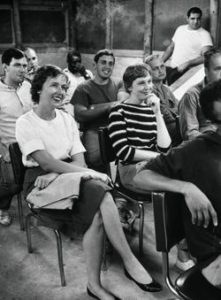
Marjorie in the white blouse in Training
Marjorie Michelmore was a twenty-three-year-old magna cum laude graduate of Smith College when she became one of the first people to apply in 1961 to the new Peace Corps.. She was an attractive, funny, and smart woman who was selected to go to Nigeria. After seven weeks of training at Harvard, her group flew to Nigeria. There she was to complete the second phase of teacher training at University College at Ibadan, fifty miles north of the capital of Lagos. By all accounts, she was an outstanding Trainee.
Then on the evening of October 13, 1961, she wrote a postcard to a boyfriend in Cambridge, Massachusetts. Here is what she had to say:
Dear Bobbo: Don’t be furious at getting a postcard. I promise a letter next time. I wanted you to see the incredible and fascinating city we were in. With all the training we had, we really were not prepared for the squalor and absolutely primitive living conditions rampant both in the city and in the bush. We had no ideas what “underdeveloped” meant. It really is a revelation and after we got over the initial horrified shock, a very rewarding experience. Everyone except us lives on the streets, cooks in the streets, sells in the streets, and even goes to the bathroom in the street. Please write. Marge.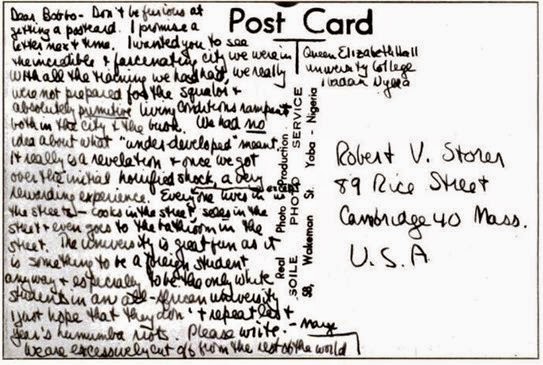
P.S. We are excessively cut off from the rest of the world.
The postcard never was mailed. It is said that it was found on the grounds of University College at Ibadan near Marjorie’s dormitory, Queen Elizabeth Hall. The finder was a Nigerian student at the college. Copies of the postcard were made and distributed. Volunteers were immediately denounced as “agents of imperialism” and “members of America’s international spy ring.”
The protest made front-page news in Nigeria and it sparked a minor international incident. As the Nigerian Ambassador to the United States put it, “No one likes to be called primitive.”
Smack in the middle of this “international incident” was Murray Frank, the thirty-four-year-old Western Regional Director of the Peace Corps in Nigeria, who had arrived in-country only weeks before the Trainees and was busy developing sites for the Volunteers when the infamous postcard was found.
*
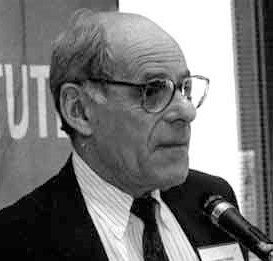
Murray Frank
In the Fall, 1999 issue of the Friends of Nigeria Newsletter, Frank recalls the Incident and those early tense days in Ibadan, Nigeria. Murray writes:
The Postcard Affair began October 14, 1961. That was the day Peace Corps Nigeria almost came to an end . . . before it started. And I was in the middle of it all.
Nigeria I had arrived in Ibadan early in October. Volunteers were settling into dormitories at the University of Ibadan (then a part of the University of London and called University College of Ibadan) where they would continue the training started at Harvard.
I was the Western Region Peace Corps Representative. My family and I arrived in September, ahead of any other Regional Representatives and their families. Brent Ashabranner, who left AID to become Nigeria’s first Peace Corps Director, helped us get settled. We had a house in Bodija, a middle-class development between the center of Ibandan and the University. Residents included professionals and senior government officials – not quite the Peace Corps mold – but quite a comfortable area for a family with children aged two and four.
I had nothing to do with Volunteer training. My job was to arrange Volunteer assignments. I would visit a potential location, meet the principal and staff, establish that there was a position for the Volunteer to fill, and check out living conditions. I had not gotten very far by Friday, October 13. But, I was getting to know Volunteers as work assignments were developing.
Volunteers went to class and studied Monday through Saturday mornings. Friday night, October 13, PCV Marjorie Michelmore wrote some letters and picture postcards to folks back home. She mailed them on the way to class Saturday morning. One of the postcards described her first impressions.
When Volunteers arrived at dormitory dining halls for lunch Saturday, October 14, there was a copy, word for word, of that postcard at each place. Marjorie’s comments described how the average Nigerian lived. While not inaccurate, her comments were not flattering, and to a Nigerian student – especially one concerned about Western imperialism – the comments seemed downright insulting.
A couple of Volunteers hitched a ride from the university to bring me the news. Protests were beginning on campus, Volunteers were being ostracized. This was clearly not a training issue. Now, I was in charge.
I arranged for all of the Volunteers to come to my house while I went to the USIS library to phone Lagos. I didn’t have a phone. I told Ashabranner what I knew. He cabled Peace Corps Washington.
By coincidence, the second-in-command at the American Embassy, the Deputy Chief of Mission, was on his way back to Lagos after a trip up North when the story broke. I met him at a local rest house with Marjorie and we agreed that she should go with him to Lagos. There was an AP stringer at the rest house. He could see that something was up.
I went home to meet with Nigeria I Volunteers. I was totally unprepared for this.
Initially the group felt anger – at Marjorie for getting us into this, at the Nigerians for making such a big deal out of one person’s comments on a postcard and holding us all responsible. Should we issue a statement disassociating ourselves? If so, to whom? How? We got by that quickly and went on to examine how representative these students and their feelings were of the country, and especially of the people with whom we would be working
We knew that Nigeria was newly independent but, in retrospect, I don’t know if we fully absorbed how deeply this influenced the students’ behavior. It had not been very long since independence had been won. The visages of the colonial period were still all around, including and especially white people who symbolized a colonial past. A Nigerian self-image based on new freedom was developing. Nigerians, at least by this group of young intellectuals, demanded respect.
I understood it better after I attended the inauguration ceremonies when the University College of Ibadan became the independent University of Ibadan. Nnamdi Azikiwe (Zeke), the father of independence, was the main attraction. When it was his turn to speak, the excitement – the electricity – in the crowd was palpable. A zzzZZZEKE cheer went wherever he did. They cheered and cried for him and for the event that reaffirmed independence. Zeke insisted that the University of Ibadan was “our” university, free of London’s influence and now part of Nigeria’s development. It was thrilling – the closest I ever came to such intense nationalism.
But on October 14, 1961, most of us had just confronted this intense nationalism for the first time. All of us had experienced student protests in the States. But this was quite different. It was not really about a postcard. We knew there were those who opposed foreigners “invading” their country and those who would use this incident for their own purposes. Some feared that we would not really be able to help Nigerians if that was how we wrote home about them.
We asked many questions. Do we have a choice, or have our chances of success been reduced significantly? Why try to stay where so many don’t want us? Shouldn’t we go somewhere else where we are invited and start fresh? Can we continue to live and train at the University where there is such hostility toward us?
And then the counter arguments came. We know Nigeria needs teachers. We can teach. We are not imperialists, nor CIA agents, nor ugly Americans. We know who we are. We can make a difference.
We were agitated but the discussion was mostly calm, always serious. It was hard work that afternoon. Consensus was a long time in coming. I saw my role as the discussion leader. These were the folks who would be on the firing line. They had to decide for themselves.
We were all young. The oldest in that room was 34. We were newly transplanted to a very different culture, confronted with a situation for which none of us had any real preparation. But the Volunteers had spirit and maturity.
We continued to try to answer many questions. What are we doing here? Should we leave, or stay and prove that we have something to give? After many hours we made a decision.
We wanted to stay.
That decision by this group of “Kennedy Kids” made all the difference in their lives, and in fact, made all the difference in the future of the Peace Corps. If they had ‘cut and run,’ giving up at the first brush up against a hostile group of HCNs who did not know the reason these Americans were in Nigeria, it is a good chance that the fledgling Peace Corps would not have survived.
*
According to Warren Wiggins, then the Associate Director for the Office of Program Development and Operations, and later the Deputy Director, he was waiting for something to happen overseas with the Volunteers. Then on afternoon of October 15, 1961, they got their incident when word reached Washington about Marjorie Michelmore and her postcard.

Warren Wiggins
Gathering at HQ on that October Sunday afternoon, the senior staff was initially worried about Marjorie’s life, as well as the lives of the other Volunteers. Wiggins also realized that “The Peace Corps could be thrown out at any moment. It could be the domino theory–first we’re kicked out of Nigeria, then out of Ghana, and so on. Anything was possible.” It would be the end of the Peace Corps before it had really started.
At first there were rumors. One was [it was incorrect] that the U.S. Ambassador in Lagos, Joseph Palmer, was trying to force Marjorie out of the country against her will. Then the Peace Corps heard from Marjorie herself. She cabled Shriver telling him that it would be best for the Peace Corps, and best for her, if she came home immediately. The word was sent back to Africa from PC/HQ: get Michelmore out of the Nigeria.
Wiggins always said Shriver was calm and cool in such moments of crisis. Hemingway’s grace under pressure. But the courtly–as I recall him–Tim Adams, who had just come to the Peace Corps from the San Francisco Examiner to be the new public information officer for the agency, told Coates Redmon that by Monday morning when the story broke in the press there was, “panic in Shriver’s heart. There really was. That postcard had created a cause celebre. It was temporarily the talk of the universe.”
Shriver, however, was determined to outsmart the press. He didn’t want them meeting Michelmore when she arrived in the U.S. after a long overnight flight from Africa. He was afraid of what she might say. And what would they ask her about the new Peace Corps? Were these young white American kids up to living in Africa? Anything was possible and it would all be bad for the Peace Corps.
Shriver came up with a plan: Michelmore would fly from Lagos to London, then fly directly to Bermuda, and onto San Juan, Puerto Rico, where she would join up with Trainees at the new Peace Corps Outward Bound camp. She would then “impart cultural sensitivity caveats to the Peace Corps trainees.”
Tom Mathews, deputy director of Public Information, was dispatched to Bermuda to pick up Michelmore when she arrived on the island and fly on with her to Puerto Rico. [Marjorie’s escort officer from Lagos was a guy named Dick Ware, an AID official in Nigeria, and who was about to joined the Peace Corps Staff. He would make sure to keep Marjorie away from the press leaving Lagos and on the layover in London.] All bases were covered.
Then, two nights later–the night Marjorie and Dick Ware are flying across the Atlantic– shortly after 2 a.m. EST, Tim Adams, got an urgent call from Wiggins. Warren had heard from Tom Mathews in Bermuda. The island was socked in and Marjorie’s plane was being diverted to Idlewild in New York. Shriver, Wiggins said, wanted Tim to get to New York before her BOAC plane landed. Sarge Shriver wanted to make sure that the first Peace Corps ET, Marjorie Michelmore, was kept away from the American press.
*
The next day in Nigeria, the next day in America, Marjorie’s postcard appeared in every newspaper; it was reported on the radio, and it was seen on television. The whole world knew what had happened in Africa with this young Peace Corps Volunteer. Within days, former president Eisenhower would make a political speech in Madison Square Garden in which he said that the U.S. should send Peace Corps Volunteers to the moon since it was also an underdeveloped country and they could do less harm there.
However, columnist James Weschsler of the New York Post came to the aid of the Peace Corps and Marjorie. “Nothing in the card was sinister. It contained the instinctive expression of horror of an affluent American girl in her first direct encounter with the gruesome squalor of Nigeria. She was neither patronizing nor self-righteous in her comment; yet, whoever found the lost card managed to stage a big production.”
Out in Ibadan, Murray and his Nigerian Volunteers waited for directives from Washington, waited from advice from the Peace Corps HQ. There was no cable traffic from D.C.
Finally, a telegram arrived. It was from the State Department back in Washington, D.C. The cable asked only one question: “Were there really over 256 words on one side of the postcard?”
Don’t you just love the way the State Department thinks?
*
Michelmore, meanwhile, was getting support from Nigerian writing letters to Nigerian newspapers. Tai Solarin in the Lagos Daily Times wrote, “not a single Nigerian who knew this part of Nigeria would suggest that she was sending home a make-up story.”
While the PCVs at University College of Ibadan might not have known it at first, the Volunteers were also getting help from Washington. Shriver met with the President as soon as the news broke, telegrams were going back and forth between the Peace Corps and Sam Proctor, the Peace Corps Director in Nigeria, on how to handle the situation.
Nigerian PCV Aubrey Brown, who had had training and experience in non-violence resistance in the late fifties, led
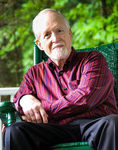
Aubrey Brown
the Volunteers, and the Nigerian students, out of this confrontation over the postcard. The PCVs had continued to take some meals and sleep in the dormitories, but they were isolated and shunned by the Nigerian students. Then Aubrey told the Nigerian students in his dorm that he would not eat if they would not eat with him.
The Nigerians began to bring him dinner trays to his room but he refused to eat. And soon they invited him to join them at meals. Other Volunteers and students did the same. Slowly, a dialogue began between the students and the Volunteers, which was, as Murray recalls, “more valuable than if the incident had not taken place.”
Other Nigerians came to the help of the PCVs. The Nigerian-American Society, an organization of Nigerians trained in America, wrote letters to the editors of newspapers. One man, H.A. Oluwasanmi, who taught agronomy at the University of Ibadan and later was Chancellor the University of Ife, gave not only support to the Volunteers and Murray Frank, but his advice on how to understand the situation was, in Murray’s word, “invaluable.”
Richard Taiwo, an engineer in one of the Western Region ministries and a warm and wonderful man and supporter of the Peace Corps, praised the Volunteers and organized with others a party for all the PCVs at a very visible club in Ibadan, where there was plenty of Star beer and lessons in Highlife.
The Peace Corps in Nigeria also got help from Tai Solarin, principal of the Mayflower School, which he founded and named for our Mayflower, who came to the side of the Volunteers. If it wasn’t for these men, and the Nigerian-American group, Murray Franks now believes, “We might not have made it.”
In the aftermath of the incident, Murray would write, “PCVs remained calm and were not retaliatory with Nigerians who taunted them. These young men and women balanced individuality and group allegiance, knowing that the issues were not personal. They remained reasonably self-confident and able to listen and learn.”
The first real crisis of the Peace Corps and on-the-job training of what it meant to be a PCV had been averted and the infamous postcard turned into a moment of understanding and acceptance by all. The Kennedy Kids had shown their detractors in the United States that they weren’t kids. And as Murray Frank, who guided them successfully through all these first months in Africa, summed up years later, “I would hope that if any new PCVs go to Nigeria they will be as good as the Nigeria I Volunteers. They couldn’t be better.”
Marjorie, too, was well aware of what was happening around her because of the postcard. She would later write Kennedy, “I regret very much my part in the unfortunate affair at Ibadan. I hope that the embarrassment is caused the country and the peace corps effort will be neither serious nor lasting.
Marjorie was right. Five months after the postcard incident the second group of Volunteers arrived in Nigeria and were met at the airport by Prime Minister Abubakar Belewwa.
*
Tim Adams arrived at Idlewild Airport to a terminal overwhelmed with press people carrying tape recorders, cameras, and microphones. Michelmore and Ware were about to touch down on a BOAC flight and Adams saddled up to a group of reporters and asked innocently, “Who’s coming in?” Adams thought it might be Grace Kelly, then due back in the States. “It’s that Peace Corps girl,” someone said and Tim’s heart dropped.
Slipping away from the reporters, Adams pulled out his official government Peace Corps ID and got past the customs officials and when the BOAC flight landed pulled Marjorie and Dick Ware into an empty room. The reporters, however, could see them on the other side of Customs, see Tim frantically telephoning Shriver at the Peace Corps Headquarters. Tim asked what he should do. Shriver told him, “Tim, I don’t want the press talking to Michelmore.”
Adams told Shriver that there was no way Marjorie couldn’t talk to the reporters. When Shriver didn’t respond, Tim took it as an opportunity to hang up. With Marjorie and Dick Ware behind him, Adams went out to handle the press conference.
Grabbing a chair, he jumped up and told the swarming reporters that Miss Michelmore was very tired and that she would take only a few questions. Reporters were given five minutes. T.V. and radio got another five minutes. It worked. That night, Marjorie Michelmore was charming, attractive, and normal, and it was all over the next’s day’s papers and on the nightly news.
*
By now at Idlewild a half dozen more Peace Corps HQ people had arrived, all having been dispatched from D.C. These were some of the famous original staffers at the agency: Ruth Olson operated as crisis manager for the occasion. She was well versed for the job. She had come to the Peace Corps in the first week of the agency from years of working in the military during World War II; Betty Harris, a former journalist and political operative from Texas was on hand; Tom Matthews had just come up from Bermuda. And also arriving unannounced and unexpected, sneaking through the press of people, was Marjorie’s boyfriend from Boston, an NAACP lawyer.
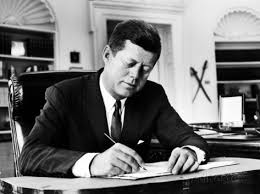 Marjorie had already heard from JFK. When she arrived in London she received a telegram from the President, dated October 18, 1961, saying, “Dear Miss Michelmore, I want you to know that we are most appreciative of your steadfastness in recent days. We are strongly behind you and hope that you will continue to serve in the Peace Corps. Sincerely, John F. Kennedy.”
Marjorie had already heard from JFK. When she arrived in London she received a telegram from the President, dated October 18, 1961, saying, “Dear Miss Michelmore, I want you to know that we are most appreciative of your steadfastness in recent days. We are strongly behind you and hope that you will continue to serve in the Peace Corps. Sincerely, John F. Kennedy.”
When the press cleared out, Tom Mathews headed back to Washington to brief Shriver on what had happened. Tim Adams and the others got tickets for the next flight to Puerto Rico.
There was, however, a new problem for the Peace Corps. Marjorie Michelmore didn’t want to go to the Peace Corps’ Outward Bound camp in Arecibo, Puerto Rico. She had heard–via the Peace Corps Volunteer network that Camp Arecibo was “all Tarzan”– and that wasn’t her style. Tim was back on the phone to Shriver in D.C.
At Idlewild Tim Adams, Ruth Olson and Betty Harris convinced Margorie to go to Puerto Rico. Michelmore agreed to go for a ‘few days’ and Tim informed Shriver, telling Sarge he would keep in touch. He boarded the plane with Ruth Olson and Marjorie, thinking that once he was on the plane to Puerto Rico, he’ll be okay.
Tim was wrong.
On the plane, Adams recognized Carl Mydans. It the time Mydans was a famous photojournalist, one of the giants for Life Magazine. Adams thinks: this is not a coincidence. With Mydans was a young woman reporter, Marjorie Byers. They were in first class. Of course, this is Life Magazine.
When they are airborne, Carl walks back from first class to talk to Tim who is riding in coach. [Of course, he works for the Peace Corps.] “Carl is such a gentleman,” Tim says, “I finally relented and we were able to negotiate terms under which Mydans and Marjorie Byers could get an interview with Michelmore after we all arrived in Puerto Rico.”
When they arrived in San Juan they are met by Rafael Sancho-Bonet, then the Peace Corps’ overall administrator in Puerto Rico [later he would be the CD in Chile.] Rafael drives them all to meet William Sloane Coffin, the director of the camp. Coffin is famous, especially in his own mind, and had been a chaplain at Yale, later an antiwar spokesman, later still, the Senior Minister at Riverside Church in New York City. In the Peace Corps Coffin was well liked, and well hated.
That day he was pissed Michelmore had been “foisted on him” by Shriver. He did not want her in his camp.[Of course, Marjorie didn’t want to be there either.]
Coffin position was, “I want it made clear that this girl is going to be treated just like everybody else here. Up before dawn, rappel down the dam, do drown proofing, and conquer the obstacle course, etcetera.”
Marjorie wasn’t going to have any of it. “I will do this for a couple days to accommodate the Peace Corps,” she tells all of them, “but I view it as an unnecessarily punitive action, and there is a limit. If I am not permitted to leave very, very soon, I will leave on my own.”
“Marjorie wasn’t kidding,” recalled Adams. “She was ladylike, but tough. And she just wasn’t going to take any shit from Coffin.”
Something had to be done, and it was, by Ruth Olson, Rafael Sancho-Bonet, and Tim Adams. They handled this ‘incident’ for the Peace Corps. They got Michelmore, to use early Peace Corps terminology, ‘in, up, and out’ of Arecibo within two days.
*
In 1965 Bob Gale, then running the Peace Corps Recruitment Office, traveled out to Ibadan, Nigeria, for a COS Conference. Gale had been a vice president at Carlton College and had developed the famous Peace Corps recruitment blitz [the most famous of all was the first in early October 1963 when teams of recruiters hit college campuses; these were mostly non-RPCVs as the first PCVs were just arriving back in the States. These all-out assaults on college campuses were very successful at recruiting Trainees. These early blitz teams were replaced by ’67 with teams of RPCVs working out of regional offices, and today no one recruits. Potential PCVs sign up for the Peace Corps on the Internet.]
Back in Nigeria, Gale arrived late in Ibadan from Washington and met up with a Nigeria APCD and headed for a local bar where he was the only white man having a drink. Then in walked another huge white American kid and a smaller African. Gale recognized the American. He had recently been the co-captain of the Carlton College football team when Gale was there, and was a PCV in Ghana. He was hitchhiking through Nigeria and had been picked up by this smaller Nigerian who, when learning his rider was a Peace Corps Volunteer, immediately told him that he was the person who had discovered the famous postcard of October 1961, four years earlier.
The Nigerian explained that he was then working at the post office in Ibadan and had been told by a group of left-wing students at the University to look for any postcards from PCVs that might discredit the Peace Corps.
In her book, Come As You Are Coates Redmon asked an RPCV from Nigeria about the claim and the RPCV replied that “We’ve heard stories and stories. I think that no one knows the whole truth. But one thing is certain. Peace Corps Volunteers in Nigeria never send postcards. They are haunted.”
*
The “Peace Corps Postcard” had one more act to play. Marjorie Michelmore story inspired a Broadway musical, Hot Spot. It starred Judy Holliday in her last Broadway show. Premiering on April 19, 1963 at the Majestic Theater in New York, the play closed after only 43 performances and 5 previews, gaining the honor of being one of Broadway’s most famous flops.
The play was about a Peace Corps Volunteer, a hygiene teacher “Sally Hopwinder,” who is stationed in a fictional nation, “D’hum.” PCV Hopwinder concocts a plan to obtain U.S. aid for D’hum by convincing the Pentagon that Russia is about to invade it. It was generally accepted that this political satire was inspired by the furor over the Michelmore postcard. “The New York Times drama critic wrote, “a Peace Corps girl with a warm heart and a knack for getting herself and her country into trouble.”
According to Steven Suskin, The New York theater critic, “it was one of those big-budget, big-advance-sale bonanzas which go wrong and turn into highly public busts.” In a review in Billboard, “Predictions of failure proceeded the show and these were confirmed when the New York Critics Circle passed a unanimous negative judgment.”
In his book, When The World Calls:The Inside Story of the Peace Corps and its First Fifty Years, Stanley Meisler writes, “Since the role was played by the delightful Judy Holliday, the Peace Corps could hardly complain about the attention.”
*
And so our story ends and the curtain comes down on the famous postcard incident. We all know, and we all remember, the postcards and letters that we sent home and what we wrote in those postcards and letters. What happened to young and innocent Marjorie Michelmore in Nigeria could have happened to almost anyone in the Peace Corps.
So, to everyone serving overseas today remember what JFK said on the White House lawn when he nodded goodbye to us, slipped his hand into his jacket pocket, and then, almost as an afterthought, smiled and added, “But no postcards.”
Today, of course, Trump would likely say, “Send a Tweet!”
*
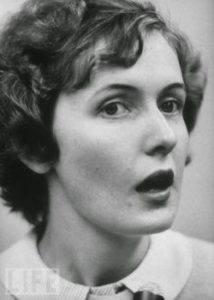
Marjorie
As for Marjorie. She returned to Peace Corps HQ from Puerto Rico with Ruth Olson and Tim Adams and went to work with Betty Harris and Sally Bowles to put out the first issue of The Peace Corps Volunteer. It was, of course, an appropriate job, as Coates Redmon states it in her book on the early days of the agency, Come As You Are: The Peace Corps Story, since Marjorie was the first returned Volunteers.
In a memorandum to Sargent Shriver–attached to an Evaluation Report on Morocco (1963) done by Ken Love–and written by the legendary early Peace Corps Director of Evaluations, Charlie Peters, Charlie wrote, “Marjorie was as sensitive and as intelligent a Volunteer as we ever had in the Peace Corps.” The lesson that was learned by the Peace Corps was that “even the best young people can be damned silly at times.”
At the Peace Corps HQ the feeling was that the agency had weathered this early storm. Warren Wiggins would write, “The greatest thing that could have happened to the Peace Corps in the beginning with a postcard from a Volunteer mentioning that people pee in the streets in Nigeria. It was like a vaccination…..Never again would a major newspaper, under the worst of conditions, streamed anything negative about the Peace Corps. Since then, the Peace Corps has had rape, manslaughter, bigamy, disappearances, Volunteers going insane, meddling in local politics, being eaten by crocodiles, but never again did it get a bad play in national news. The vaccination took; we were immune.”
The PCVs stayed and the Peace Corps program continued and grew in Nigeria. As for Marjorie? Well, early in ’62 she left the Peace Corps and married Frank Heffron
Back in the mid-90s I located Marjorie and asked her if wanted to write her account for our website. Marjorie wrote back saying, ‘thanks, but no.’
She did, however, tell her story in an interview that appeared in the Smith College’s Quarterly Magazine in 2011.
The following is Smith’s interview, the only time she has spoken at length about her ordeal.
What made you want to join the Peace Corps?
It started with Kennedy’s inaugural address in January 1961: “Ask not what your country can do for you but what you can do for your country.” I responded to that. I really wanted to be part of that whole dream. And I was very excited and proud when I was selected to be in the first group to Nigeria.
You were still in training at the University of Ibadan when you wrote the infamous postcard.
I have blocked it pretty much, so I don’t remember the text, but I remember that it was stupid and insulting. There was a leftist group on campus who thought that the Peace Corps was a front for the CIA, and they were ready to seize the first chance they could get to embarrass the Peace Corps. I either dropped the postcard or it was taken out of the mailbox. I have no idea how it was found. The students gathered, and there was a riot, or certainly an uprising. There were torches, I remember, and shouting, but I didn’t see much of it because people on the staff came and got me away.
What happened next?
There was a possibility of violence; the students were making a lot of noise. I was moved to safe places for a couple days. Then I was taken to [Nigerian Governor-General Nnamdi] Azikiwe. I apologized, and he was very gracious about it. Then I left in a plane. It was all very cloak-and-dagger. I came to New York via Rome and London, and in each place there were large press presences. By the time I got to New York, the press was pretty huge. I just had to deal with it.
It was in London that you received a cable from President Kennedy.
I’ll read it to you. It’s dated October 18, 1961. It says, “Dear Miss Michelmore, I want you to know that we are most appreciative of your steadfastness in recent days. We are strongly behind you and hope that you will continue to serve in the Peace Corps. Sincerely, John F. Kennedy.”
What did his support mean to you?
It really mattered, because I was devastated. I felt that I had let down the president; I possibly thought I might have wrecked the whole Peace Corps idea, and I let down my friends in the group and actually put them in some jeopardy. I’d been through quite a lot of stuff. So for him to say “we’re strongly behind you” was just amazing.
How have you coped?
I never talked about it—ever—to anybody, even my best friends. I never knew whether they knew about it, because of course my name had changed. So when I went to a new town and made friends, I obviously didn’t ever bring it up. From the beginning I felt it was a stupid and insulting thing for me to do, and I was ashamed of it.
Have you been able to forgive yourself?
Oh, I live with some regrets.
What remains of your Peace Corps days?
Two boxes. My mother kept everything—all the letters that came from all over the place, and the press stuff. I don’t think I want to go through those cartons. I’ve tried a couple times, because we’ve been carting them around, house to house. But I start reading the letters from angry people—there are a lot of wonderful letters in there, too—and it brings it all back, and I close the cartons.
Clarice (Reese) Heller Berman ’61 told me she felt only sympathy for you because “it was something anybody could have done.” Is this how most of your fellow volunteers reacted?
Yes, it was, but I didn’t know that until I finally went to the fortieth reunion of Nigeria I ten years ago. Reese told me that; other people told me that. It was just so warm and welcoming. That healed a lot of the pain I’ve always felt about the whole thing.
In closing, one last note on Marjorie Michelmore Heffron. She earned a Master of Arts degree from Columbia University and worked for Harvard University as director for media relations before becoming an associate vice president for university relations at Binghamton University. When she retired she and her husband returned to live in Exeter for the last 12 years of her life. Until her death from cancer in 2011 she continued to work as a freelance writer and editor and wrote a biography of Louisa Catherine Adams, wife of the sixth U.S. president published by Yale University shortly after her death. In previous articles I have written about Marjorie, I said she was certainly the most famous Peace Corps Volunteer. I continue to think so.
*
What you see here is the original cartoon Ellen Kennedy, wife of Padraic Kennedy, first Chief of the Division of Volunteer Field Support –1961-65–purchased from The New Yorker cartoonist. Ellen and Pat Kennedy kindly gave the cartoon to me and I will give to the NPCA when they open their RPCV museum at their offices in Washington, D.C. next spring. The New Yorker, as only they would, found humor in the situation and published this cartoon.
“Do you think it would be all right on a postcard to mention frozen foods,
dirty streets, crowded tenements, TV commercials, and things like that?”
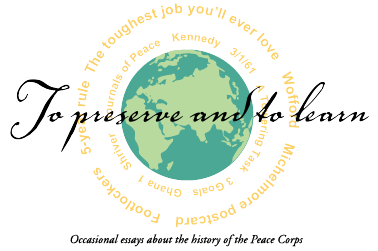
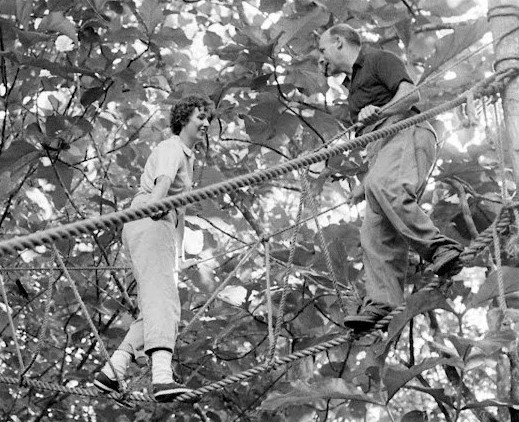
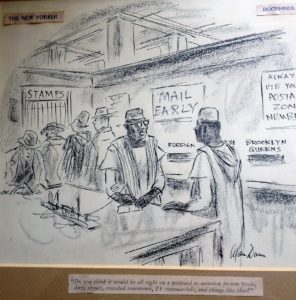
John thanks for this. I never did read the complete story before. You have done all of us a great service. The Towering Task premiere was terrific.
There were details in the story that I had never seen before — esp. what became of Marjorie Michelmore. Thanks to John C. for putting it together like this.
Great story. If a few of my first letters had been opened, maybe there would have been an issue. God bless Marjorie Michelmore. Any old RPCV can appreciate her dilemma!!!
Good job, John.
Great read, John. Thanks. As said above, Marjorie’s story could easily have been any of ours. I would guess that virtually every country in which the Peace Corps has served have such stories to tell. That we have survived all of them speaks for itself.
hi John: Excellent article. I had only a very vague idea of all this. I found this article fascinating–and loved the NY cartoon. Thanks very much for this fascinating history.
EACH OF US WHO SERVED IN THE PEACE CORPS, ESPECIALLY IN THE EARLY DAYS, WILL RESONATE WITH THIS STORY. WE SERVED AT A TIME WHEN THE INSTINCT FOR RAPPROCHEMENT WITH OTHERS IN THE WORLD WAS AT PERIGEE; TODAY WE ARE AT APOGEE. CAN ANYONE IMAGINE THE REAL DONALD UNDERSTANDING THE PEACE cORPS, MUCH LESS SUPPORTING IT? NICHOLAS ECKER-RACZ NEPAL II
Probability is a factor. It was highly probable that someone of Marjorie’s pedigree and education would write with such alacrity about everyday life in the environment she encountered upon arriving at her post. A review of the pedigrees of the first recruits of the nascent Peace Corps in its early or formative years would confirm that a substantial proportion of recruits who were successful in training and made the “cut” to be posted, would have verbalized their initial reactions very similarly. In retrospect she should have written her boyfriend on a sealed aerogramme as postcards were a kind of novelty in the early ’60s and we’re often kept as souvenirs of postal employees in countries to which American’s were likely to be posted. As I discovered my self in 1963 in Nepal, as a member of Group 2. it was a mistake to have brought with me a Polaroid camera my wealthy and educated (physician) uncle bestowed upon me when l boarded my plane to the Far East
Per :Phillip B’s comment about using sealable air-letters, (those ubiquitous blue foldovers), simply being sealed was no protection, as the early PCVs in Ghana would find. Having air-letters opened, and then in a gesture of postal integirity, taping them shut and sending them on was simply a fact of life. Eventually I would resort to cliches and analogies that only an American would comprehend. We all had heard about the infamous postcard, and been warned about what we said.
No Ghana PCV that I know of ever was penalized or embarrassed by having their correspondence read.
Perhaps the best story was about an air-letter which was opened and read at the Post Office, the clerk took issue with something the PCV had written, and in the margin, wrote “This is not true ! ! “, then dutifully taped it up and sent it on to the PCV’s family at home. The story circulated all over Ghana.
Lots of memories of those early days ! John Turnbulll Ghana-3 Geology and Nyasaland/Malawi-2 Geology Assignment. 1963, -64, -65.
The Marjorie story reveals the innocence of a volunteer who simply was conveying factual events she saw in Nigeria. To the Nigerians it became a cultural insult which caused a negative reaction against the first PCV. With patience and tolerance they endured the mishap and things normalized again. Later the Nigerian leaders embraced the Peace Corps fully. What a drama it was.
It’s too sad that conditions in Nigeria today have hot changed much for the better since the date of the postcard. Nigeria is still a 3rd world country, mainly becuase it is 1st class when it comes to corruption!
ed murphy a PCV in Maidurguri Nigeria (which is now home to the Boko Haram!)
I spent two years (1964-1966) as a Peace Corps teacher in Northern Nigeria. During my Peace Corps training the “Marjorie Michelmore” event was certainly pointed out to us, and I always used the “blue fold overs” during my Nigeria stay. There were times when I certainly might have written the same things that Marjorie wrote, but I always tried to soften the description a bit and to always include something positive about the wonderful Nigerian people that I worked with and served.
Thanks for this sympathetic description of all of the facts.
[…] tries to avoid doing harm, it’s still an imperfect organization. I won’t deny seeing white saviors among my fellow Volunteers, and I can never say with complete confidence that I never perpetuated any stereotypes […]